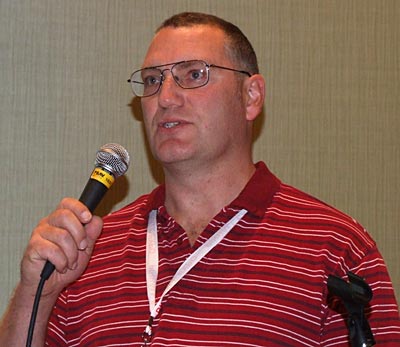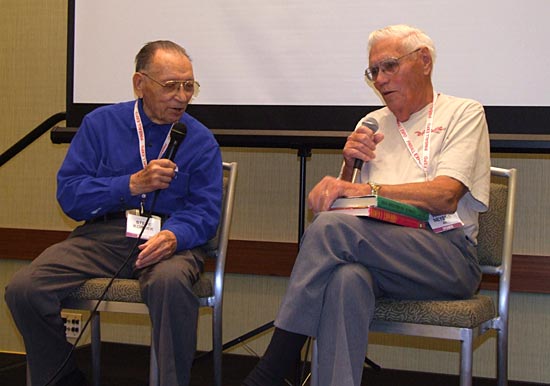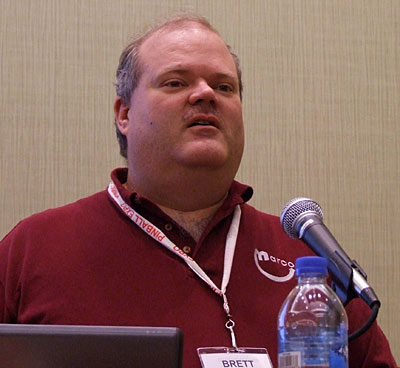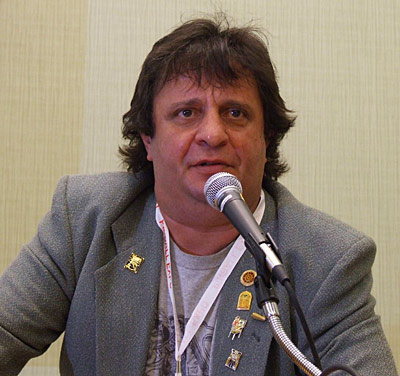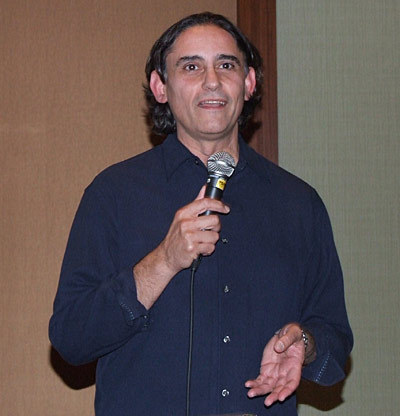| PINBALL EXPO 2008 |
| Date: 1st - 5th October 2008. The Saturday seminars are a relatively new phenomena. Until recently, all the seminars took place on Thursday or Friday but the number of speakers, their limited availability and the drive to offer more value to attendees led to one or two Saturday events. This year saw the most Saturday seminars yet, and as you will see, they are just as interesting as their weekday counterparts. The action moved from the Botanic Ballroom to the smaller Lake Michigan Ballroom while the former was prepared for the evening's banquet. The first Saturday speaker this year was John Greatwich from Canada.
Pinball News first revealed John's plans to restore or reversion pinball playfields back in August 2005.
John prints his artwork using a HP (previously MacDermid) ColorSpan 9840 flatbed printer which can handle sheets up to 4 feet by 8 feet wide and 2.375 inches thick and costs around $150,000. Playfield artwork tested so far includes Sorcerer, two version of Space Shuttle, Eight Ball Deluxe, High Speed and Star Gazer with work underway on Sea Witch. John says the playfield he has received so far are "trashed" and the results after printing have been amazing. To ensure the print surface is flat in order to prevent the print head colliding with the wood, the playfields are screwed down to half inch thick MDF before they are fed into the printer. Several test prints are made by taping thin paper over the playfields and printing in draft mode to check the alignment and make adjustments where necessary to ensure the lower part of the playfield printing is aligned to the insert and feature holes as closely as possible. John showed a number of video clips demonstrating the various stages of the direct ink process, ranging from repairing, initial sanding to remove all existing artwork, masking, laying down a white layer to boost the final colours and a thin clear coat to seal it before heading for the printer.
John reiterated his offer to re-print one playfield for free to anyone contributing the artwork files. Once the process has been proven to work, the amount of artwork available determines which titles can be printed. Get the Flash Player to hear this audio clip.
Want to download this seminar? Click here to play the MP3 version or right click to save it.
10:00am Reminiscing with Steve & Wayne - Steve Kordek & Wayne Neyens Steve and Wayne are two of the great stalwarts of Pinball Expo, coming each year to chat and meet the pinball fans despite being almost 97 and 90 years old respectively.
They are two of the most prolific pinball designers. Wayne worked at Gottlieb for many years while Steve started at Genco before moving to Bally and then Williams. Competitors during their careers, they are now good friends in their retirement. Fellow designer Norm Clark was also in the audience and he joined Steve and Wayne at the front of the room.
Wayne said he started in pinball in February 1936 as a draughtsman at Western Equipment & Supply and Steve began in April 1937 as a solderer at Genco before they both got into designing. Steve then described how he left college to get a job and help support his family during the depression of the early 1930s. After being unexpectedly offered a soldering job at Genco while sheltering from the rain, he put his electrical training to use to diagnose faults and progressed to the Engineering Department. There he studied with Harvey Heiss who taught Steve how to design games. He was to subsequently put that knowledge to use when Harvey was taken ill and Steve had to design a game for the upcoming trade show. The game Steve designed was Triple Action and it was the first to have flippers at the bottom of the playfield, where they have been ever since. Steve said he copied the electrical player-operated flipper idea invented by Harry Mabs in his Humpty Dumpty game, but as Harvey had taught Steve to be conservative in his designs, instead of the six flippers used by Harry, Steve used just the two. Steve stayed with Genco until they closed in 1957, after which he went to Bally for a few months until 1960 when he joined Harry Williams at his recently formed company bearing his name. It was there Steve met Norm Clark as the two of them worked side by side designing games for Williams. Wayne then spoke about how some well known people had been involved in pinball’s history including two US senators and the financial guru Warren Buffett who was a pinball game operator when he was at high school. Talking about when the flipper was invented at Gottlieb, Wayne said he was present when Harry demonstrated this new device and they were all very excited. He described Harry Mabs as a big ideas man with more ideas than he knew what to do with. The flipper was originally going to be automatically operated as the ball rolled over a switch, but he tried touching the wires together manually and found it produced a fun device to play with. So Gottlieb made the game with six flippers and not-too-surprisingly called it Flipper. Unfortunately the name Flipper was already used so it was re-themed to Humpty Dumpty. Once the flipper was established, numerous games were converted to include flippers using kits and despite vowing never to build a game with flippers, United’s Lyn Durant soon found he couldn’t sell a game without them. Wayne said the flipper was the idea that saved the industry and turned a gambling game into a game of skill.
Steve then described how United’s Lyn Durant and Harry Williams, after working together running the company decided they should go their separate ways and with a toss of a coin, it was Durant who stayed at United while Williams left to set up his own company. Harry Mabs joined Williams soon after and Steve also joined to work with Mabs until his retirement . Steve stayed with the Williams company until 1998, a total of 61 years in the industry. There was always something exciting, he said, always something new. He described how Genco turned from a highly profitable enterprise into a loss making one after the three Gensburg brothers turned their business acumen away from the amusement machines industry into property and casinos. They left the pinball business to a couple of college graduate relatives who slowly ran it down until it closed in 1957. With game designer Harry Mabs working at Gottlieb, Wayne’s job there was to build test fixtures. He quickly mastered that and would try fixing them to playfield sheets and adding other fixtures to mock up a game over the course of about 12 months. Although he said he did it more to amuse himself, the design was adopted and manufactured, so Wayne tried a different layout and slowly he began to design more and more games alongside Mabs. When Mabs left to join Williams, Wayne was offered the sole designer job which he maintained at Gottlieb` for 15 years. Get the Flash Player to hear this audio clip.
Want to download this seminar? Click here to play the MP3 version or right click to save it.
11:15am Re-engineering Pinball Circuit Boards - Brett Davis Brett designed the PinScore replacement LED pinball displays which are sold through Marco Specialties.
Brett said he first looks at pinball circuits to identify those which commonly suffer from problems or which are becoming obsolete and difficult to source. He then talks to pinball people to find out where the problems are, what fails and why. With that knowledge he moves on research the existing design, find out all the different variations that may have been manufactured and installed. The documentation available is often wrong, Brett said, and the mounting holes were often moved with different board revisions. Playing a game where the displays were either not working or failing was a major irritant for Brett, so he investigated the current LED replacements available and found that although they removed the necessity for a high voltage supply , the current they drew from the 5V line was far beyond the rated figure. Any design he came up with would need to drastically reduce the current used. He did this using a combination of field-effect transistors (FETs) rather than conventional transistor arrays and custom-designed LEDs which drew half the current of a traditional LED. The existing replacements were also often seen as too bright, so Brett wanted to include in his design the ability to adjust the brightness. He said traditionally the method to achieve this is to use pulse-width modulation to turn the display on and off very quickly and to vary the time it is turned on to change the brightness. Brett said this was overkill for a display and required more circuitry than he wanted, so he simply varies the current to produce the same effect. Finally, he wanted to include circuitry to show that the board was fully working, to allow owners to diagnose any display problems by eliminating the actual display as the faulty component. Having designed and built his prototype boards, he then went about testing them, both in a wide variety of real games and also in a test oven to find any weaknesses or points of failure. At the time of the seminar, Brett said he’d sold over a thousand individual boards and he has tested them in over 70% of the titles with which they are designed to work. For those games he hasn’t yet tested, he said those owners have his undivided attention if they want to put his boards in their games. Get the Flash Player to hear this audio clip.
Want to download this seminar? Click here to play the MP3 version or right click to save it.
He cited as the first problem the lack on innovation and introduction of new technologies to increase reliability and reduce servicing, as had happened in many other industries. Any revival would need to use new techniques and systems to overcome these failings, he said. His second point was to educate the young to enjoy and develop "the miniature amusement parks that pinballs are". The third problem which would have to be overcome related to the coin-op industry as a whole. Python said the passion and commitment had gone out of the business and operators were only looking for a quick buck, rather than taking pride in - and developing - the products they offered the playing public. Python said pinball could not go on as it is now, but it needed someone with enough money not to be constantly looking at each quarter's earnings - a "fool" as he called them - with the courage and passion to bring pinball out of its coma. When the money men took control from those who lived and breathed pinball, he continued, the formulaic games began in the same way the video game and movie industries had churned out familiar, safe, unimaginative products. Audiences could spot this paucity of ideas and couldn't be fooled. However, if pinball could once again introduce those new, exciting ideas back into the game, players would return along with the next generation of pinball fans. It was, he said, symptomatic of a much wider cultural crisis. Having spent time working in China and Japan, he said that although they were once famed for their abilities to copy western products, these countries now had the imagination and the ideas which are lacking in the west. Python said he though his Pinball Circus upright cabinet style was where pinball should have gone. He said it earned 3-4 times as much as a regular pinball in test locations but the return on investment wasn't enough, so when Williams decided not to produce it, he left to join Capcom, thinking he'd have the creative freedom to make innovative games like Pinball Circus.
He went on to describe some of his subsequent designs including a game where the player puts their head in a clear glass bubble at the playfield level behind the flippers and his design for the game Zingy Bingy. Many of the rumours about Zingy Bingy were false, Python said. It was not a pornographic game, but was merely a spoof on the eternal battle of the sexes. It incorporated a number of innovations such as a playfield which slides out, allowing easy access to both sides for servicing, only two playfield plastics which could be easily removed to access all the playfield devices, and a suitably-placed flipper which changed size! He promised to return to Pinball Expo next year along with Bryan Hansen to show some of the design ideas they created together. Python dismissed the idea of combining pinball and redemption games saying they had tried the concept before but any increase in takings from redemption game players was more than negated by the alienation of the pinball regulars who turned their backs on this new hybrid device. Similarly, he said, concentrating on the home market was the wrong way to think about the problem. Rather than chase smaller and smaller market sectors, he reiterated how the great ideas, the new innovations would shake up how pinball is designed and played, re-creating the market for pinball and opening up new avenues. Creative thinking and the means to put those ideas into practice without the constant financial scrutiny would be the saviors of pinball. Get the Flash Player to hear this audio clip.
Want to download this seminar? Click here to play the MP3 version or right click to save it.
The banquet began with the Make A Wish charity auction of donated items such as coils, magazines, playfields, t-shirts, badges, custom side art, signed artwork, posters and a lit translite as well as three complete pinball machines.
The auction was held in a light-hearted mood by Rob Berk with Mike Pacak and Darren Sheldon displaying the items. It lasted a little over 25 minutes. After the three games were sold, Rob thanked Gary Stern who gave a short speech in which he asked that everyone in the audience to not only buy games for the home but go out and play on location to make sure those sites continue to survive.
The final item in the auction was for the "Thank You Gary Stern..." sign over the tournament machines, after which the dinner was served.
One the meal was completed, the evening's guest speaker began his presentation. George Gomez is a well-known game designer, both in the video and pinball fields. He works for Midway designing Xbox and PS3 games but contributes his designs to Stern which are then developed in-house.
He said he considered himself very lucky to be able to work at pinball while retaining his existing job at Midway. When the film crew were shooting in Chicago, George got to visit the set and get a close up view of the Batmobile.
When starting his design, George said the first thing he does is come up with a lot of (mainly) bad ideas which are then whittled down until the few good ones remain. One of those which didn't survive was to lock the balls on a spinning disc like a miniature version of Judge Dredd's Deadworld. Another was to have a Batman sliding down a wire while George also investigated was to get the Batmobile to smash through various objects.
While those ideas never made it into the game, the first mock-up looks remarkably similar to what ended up on the production line.
Some of the features which changed include the three falling cards in the joker lock lane, the bat-shaped spinner, the Harvey Dent target bank and the upkicker from the Scarecrow hole to send the ball onto the crane and feeding the right inlane. Referring to the three different images shown on the joker cylinder, George said he is a big fan of reveals and discoveries during the game. The cylinder begins with a Gotham City skyline, turns to reveal the joker figure. He explained how Gary Stern thinks the casual player should get to see all the important elements of the game - such as the joker model - instead of reserving them for a more skilled player or a better than average game. So George included a second reveal where the cylinder turns again to show the large joker face seen above which is not immediately apparent but seen as the player gets further into the game. George said he writes copious notes to go along with his designs to make sure the Stern team know who he has in mind and how it can be achieved. The picture below shows some of his notes relating to the teeter-totter device.
When the artwork for Batman was being developed, Warner wanted Kevin O'Connor - the game's artist - to use imagery from the Batman style-guide for all the actors. Some of this was suitable, said George, but there was noting appropriate for several of the lesser characters so Kevin would have to create the artwork himself. Warner were initially unenthusiastic until they saw Kevin's painted portrait of Sir Michael Caine (below) after which they trusted him to paint the other characters needed for the backglass. Several designs were considered until the final arrangement (top right) with the steel logo was agreed.
Although George hands over the design to Stern to develop, he continues to liaise with Kevin on artwork changes. Some of his revisions can be seen below.
George said all his games are "seven-shot arrays" (having seven main shots from the two flippers) because he studied pinball design under Steve Ritchie and all his games were of that design. Before he added the crane into his Batman layout, he only had six shots so needed to add more things to shoot. Adding the crane gave him a much wider range of shots, allowing him to block certain lanes and features or even hit the crane as it moves across the playfield. The crane is a variation of both the blocker in NBA Fastbreak - which moves left and right to prevent the ball kicking up into the hoop - and Dracula in Monster Bash which does a similar thing but registers hits instead. His intention was to make the Batman crane ball look like an inverted retro video game joystick. Asked if there were any further revisions to the software planned, George said it wasn't up to him but being a business there are certain decisions that have to be made and they were "trying to do a lot with very little". He continued by explaining how he always designs a game to try and give feedback to the player about what they hit, and to make sure their shots always hit something, even if it's not the shot they were trying to make. Games where the shot is either made or rebounds back at the player are tough games for a novice to play, he said. In addition, a game has to be fun in its most basic form without rules or effects added. If a game is enjoyable when just flipping the ball around, it will only be improved when all the bells and whistles are added.
When questioned about his view of the industry of a whole, George explained how the growth in home sales had shifted the market and introduced new opportunities and vulnerabilities. The coin-op business was once thought to be recession-proof, but that's no longer the case, he said. Comparing this talk to Pinball Expo to his 1999 seminar where he foretold of the closing of Williams' pinball division, he said the people in charge then didn't have the stomach to keep pinball going and wanted to be running a slot machine business instead. At Stern, they had no such pretensions and were in the pinball manufacturing business for the long haul. Get the Flash Player to hear this audio clip.
Want to download this seminar? Click here to play the MP3 version or right click to save it.
After George's talk, the regular banquet award presentations began. The first plaque went to George himself for his industry work and his banquet speech. Next, Steve Kordek and Wayne Neyens were presented with awards with for their longevity in both the industry and with Pinball Expo. The first time visitors to Expo were asked to stand and applauded, followed by those who had attended 5 or more, 10 or more, and all 24 Pinball Expos. Foreign visitors were then recognised in the same way. The art contest winner was Sean O'Neil who won with his Metalocalypse-themed Zizzle game, as seen at Mike Hanley's "Pimp Your Zizzle" seminar the previous day. Mike Pacak then announced the Best Exhibitor award which went to Pinball Decals, while second place was won by Marco Specialties with their promotion of PinScore displays. A special award was then given to Gary Flower for attending all 24 Pinball Expos. He was "knighted" and given a crown to wear at this and subsequent Expos.
Gary, Greg Kmiec and Jim Schelberg then joined Rob for the announcement of the first of the evening's inductees to the Pinball Expo Hall of Fame. Greg announced that Bally pinball designer from 1963-1973, Ted Zale - a man he described as a true innovator, a prolific designer and a teacher - was the first inductee of the night.
Greg - who studied design under Ted - described how Ted created numerous innovative non-symmetrical designs incorporating a number of unique features including Nip-It's alligator, Fireball's spinning disc and the Zipper Flipper. During his ten years designing at Bally, Ted produced over seventy machines - more than one design every two months. Ted is no longer with us but his memory and games live on and were recognised in this induction. After Greg, fellow Ted student Jim Patla also spoke about his memories of Ted, his design philosophies and his many achievements.
Kevin O'Connor then announced the second inductee.
Kevin described how he took up an Art Director position at Midway in the early '80s, which is where he first met tonight's second new member of the Pinball Expo Hall of Fame, game designer George Gomez. George was working on a video game called Spy Hunter with Kevin and they subsequently collaborated on a number of games including Tron. They have worked together over the past 25 years on toys, video games and of course, pinball designs both at Williams and on George's designs for Stern.
Accepting his induction,George said it was a total surprise and a great honour. He said he had designed a lot of things in his life and pinball is definitely the most fun.
Gary Stern was the next to receive an award in honour of his company's help with Pinball Expo through the factory tour and supplying games for the tournaments. Others who help Pinball Expo to run smoothly were then thanked - John, Tom, Nona, Jim, Martin and Trent. Rob's wife Brigitt Berk was then presented with a plaque for her help in running the show. 2009 sees the 25th Pinball Expo and Rob promised even more seminars, some With that, the Banquet ended and the exhibit hall re-opened soon after, so attendees could continue playing pinball through the night.
We'll be back to conclude our Pinball Expo coverage shortly with the results from the Flip Out tournament finals held on Sunday.
|

